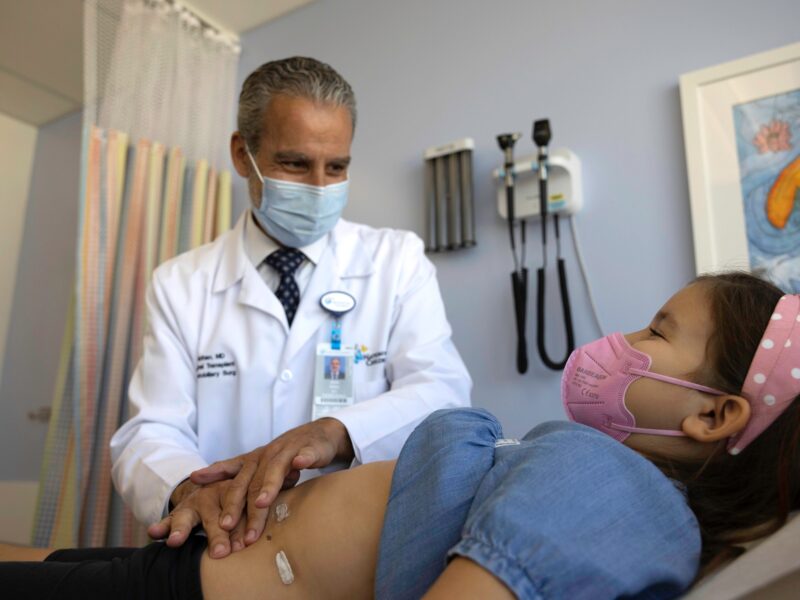A Better Non-Invasive Method To Monitor Liver Disease in Short Bowel Syndrome?
A Better Non-Invasive Method To Monitor Liver Disease in Short Bowel Syndrome? https://pediatricsnationwide.org/wp-content/themes/corpus/images/empty/thumbnail.jpg 150 150 Jeb Phillips Jeb Phillips https://pediatricsnationwide.org/wp-content/uploads/2021/03/Jeb-Phillips.jpg- February 28, 2018
- Jeb Phillips
A pilot study suggests that acoustic radiation force impulse elastography can help monitor liver disease in children with short bowel syndrome.
Patients with intestinal failure (most frequently caused by short bowel syndrome) are at risk for developing liver disease due to multiple contributing factors, including the underlying cause of their intestinal failure, need for parenteral nutrition, infections, altered intestinal flora and comorbid conditions. As laboratory studies have not proved to be an accurate reflection of the degree of liver injury, other ways of evaluating the degree of liver injury have been sought.
Liver biopsy provides the most definitive answer. However, liver biopsies are invasive with complications that include pain, bleeding, infection, bile leak and pneumothorax.
A pilot study from surgeons and physicians at Nationwide Children’s Hospital suggests that acoustic radiation force impulse (ARFI) elastography can help monitor liver disease in children with short bowel syndrome. The research was published in the Journal of Pediatric Surgery.
“Studies have shown that ultrasound can be useful in monitoring adults with liver disease, and some limited research has found elastography may be helpful in predicting liver fibrosis after transplantation in children,” says Molly Dienhart, MD, medical director of the Center for Intestinal Rehabilitation and Nutrition Support at Nationwide Children’s, member of the hospital’s Division of Gastroenterology and an author of the study.
“We believe this is the first report, though, showing efficacy of ARFI elastography in children with short bowel syndrome who are on long-term parenteral nutrition,” she says.
Eleven patients with a median age of 1.4 years were included in the study. Each patient had at least one elastography study and one paired liver biopsy – the standard of care at Nationwide Children’s is to perform a biopsy when a child is undergoing an abdominal surgery, such as ostomy takedown. (Children may also undergo percutaneous biopsies with unexplained liver deterioration).
The mean ARFI shear wave speed was significantly higher in the group whose biopsies indicated more severe liver fibrosis, and a receiver operating characteristic analysis showed that mean and median shear wave speed may be accurate in differentiating between mild and more severe fibrosis.
“We have all been hoping for a reliable, less invasive way to follow liver disease,” says Dr. Dienhart, who is also an assistant professor of Clinical Pediatrics at The Ohio State University College of Medicine. “This elastography data adds to our ability to do that.”
Nationwide Children’s now routinely performs elastography in short bowel syndrome patients, says Peter Minneci, MD, surgical director of the Center for Intestinal Rehabilitation and Support and the senior author of the study.
“A follow-up analysis that will include over 40 patients is planned in the next year,” he says. “This study will hopefully have enough power to provide definitive evidence to support the accuracy of elastography as a non-invasive method to monitor for the development of liver disease in our patients.”
Reference:
Lodwick D, Dienhart M, Cooper JN, Fung B, Lopez J, Smith S, Warren P, Balint J, Minneci PC. A pilot study of ultrasound elastography as a non-invasive method to monitor liver disease in children with short bowel syndrome. Journal of Pediatric Surgery. 2017 Jun; 52(6): 962-965.
Photo credit: Adobe Stock
About the author
Jeb is the Managing Editor, Executive Communications, in the Department of Marketing and Public Relations at Nationwide Children's Hospital. He contributes feature stories and research news to PediatricsOnline, the hospital’s electronic newsletter for physicians and other health care providers, and to Pediatrics Nationwide. He has served as a communications specialist at the Center for Injury Research and Policy at The Research Institute and came to Nationwide Children’s after 14-year career as daily newspaper reporter, most recently at The Columbus Dispatch.
-
Jeb Phillipshttps://pediatricsnationwide.org/author/jeb-phillips/October 13, 2015
-
Jeb Phillipshttps://pediatricsnationwide.org/author/jeb-phillips/
-
Jeb Phillipshttps://pediatricsnationwide.org/author/jeb-phillips/November 24, 2015
-
Jeb Phillipshttps://pediatricsnationwide.org/author/jeb-phillips/January 19, 2016
- Posted In:
- In Brief






